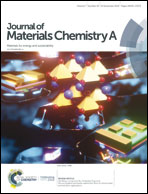Realizing high-efficiency Multiple blend polymer solar cells via a unique parallel-series working mechanism†
Abstract
The method of fabricating multiple blends including two electron acceptors has been widely adopted to improve the device performances of polymer solar cells (PSCs). When two accepters are used in the active layer of a ternary blend PSC, they are often either designed to form an alloy or connected in parallel or series. These stratagems hold various advantages that contribute to the enhancement of different device parameters of PSCs. The incorporation of more than two acceptors in a PSC is obviously interesting for extending or combining the benefits from various stratagems; however, it is yet to be accomplished due to the challenge of designing and fabricating blends with an appropriate nanostructure. Herein, we introduced a new type of PSC with three parallel-series connected molecular acceptors. This unique electron transfer structure was achieved by paving one electron transfer route using a highly crystalline acceptor and connecting two other poorly crystalline acceptors in series that provide another route in parallel. This novel nanostructure combined the broad-spectrum coverage of the parallel-connected multiple blends with the efficient charge transfer process of the series-connected multiple blends, delivering an enhanced short circuit current (Jsc) while maintaining high open-circuit voltage (Voc) and fill factor (FF). This triple-acceptor device not only delivered top power conversion efficiency (PCE) as high as 15.12%, but also, more importantly, charted a new path for the design of multi-component active layers of PSCs with high performances.



 Please wait while we load your content...
Please wait while we load your content...